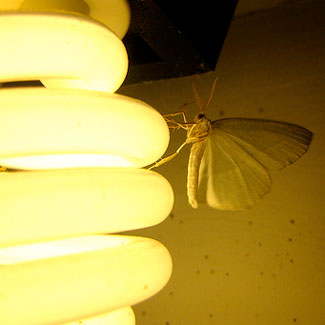Porch Lights Attracting Bugs? Choose a Better Bulb
By Chris Williams on May 8, 2014.
 Sometimes we use insects’ attraction to light to our advantage. In commercial kitchens, food warehouses, and restaurants, insect light traps are used to intercept and trap flies and other flying insects before they can contaminate food. Backyard “bug zappers” work because midges and moths are attracted to the bright light. But that same attraction can be a real annoyance on warm, sultry, summer nights when your front porch becomes an obstacle course due to an assortment of bugs buzzing around your outside lights.
Sometimes we use insects’ attraction to light to our advantage. In commercial kitchens, food warehouses, and restaurants, insect light traps are used to intercept and trap flies and other flying insects before they can contaminate food. Backyard “bug zappers” work because midges and moths are attracted to the bright light. But that same attraction can be a real annoyance on warm, sultry, summer nights when your front porch becomes an obstacle course due to an assortment of bugs buzzing around your outside lights.
Some insects are just drawn to light and entomologists are not even sure why. Some insects are attracted to light only at certain times of day, or certain times in their life cycle and avoid light at other times. Other insects are attracted to lights because that’s where they can find food in the form of those other insects that are attracted to lights. It’s not just moths. Midges, mosquitoes, ground beetles, June beetles, wood cockroaches, crickets, mayflies, lacewings, and even European hornets will collect around lights.
So, how can you keep from attracting all these bugs to your porch lights?
Use bulbs that put out less heat.
Besides being attracted to light, insects are also attracted to the heat from bulbs. Incandescent and halogen bulbs, floodlights, and lights that use a glowing filament are high in heat output or infrared energy. Cool lights that are a better choice include LED, sodium vapor, mercury vapor, fluorescent, and lamps like neon that generate light from flowing gas rather than a filament.
Be careful when choosing the tint of the bulb.
Insects are most attracted to bright white or bluish lights (mercury vapor, regular incandescent, fluorescent). Yellowish, pinkish, or orange lights (sodium vapor, halogen, dichromium yellow) are least attractive to insects. In general, yellow and “warm white” bulbs that tend to be more like sunlight are less attractive to insects than “cool white” bulbs that have a more bluish tone.
Consider LED lights.
Recently, LED bulbs have been touted as a good choice for outside lights since most LED lights don’t emit any UV light nor give off any heat. There are specialty LED lights that will attract insects, but most LEDs sold for residential lighting attract few or no insects. LED lights are energy-saving, using 1/5 to 1/10 the power of incandescent bulbs and lasting at least 10 times longer. LEDs are initially more expensive than other lights but make up the difference in the long run.
photo credit: melloveschallah via photopin cc